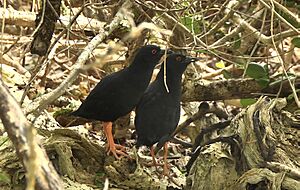Henderson crake facts for kids
Quick facts for kids Henderson crake |
|
|---|---|
 |
|
| Conservation status | |
| Scientific classification | |
| Genus: |
Zapornia
|
| Species: |
atra
|
| Synonyms | |
|
Nesophylax ater |
|
The Henderson crake or red-eyed crake (Zapornia atra) is a special kind of flightless bird in the Rallidae family. This means it's a bird that cannot fly. It lives only on Henderson Island, which is a small island in the southeast Pacific Ocean. When an animal or plant lives only in one place, it is called endemic. The Henderson crake likes to live in forests that can be dense (thick) or more open.
There are about 5,600 adult Henderson crakes. If you count all the birds, including younger ones, there are around 8,500 in total.
Contents
Where the Henderson Crake Lives
The Henderson crake can be found all over Henderson Island. It lives in different types of forests, from very thick areas to more open spaces. You can find it in forests with tall trees like Pisonia and Xylosma. It also lives in thick bushes of Timonius. Near the beaches, it likes forests with Pandanus, Thespesia, and Argusia trees, and even in areas with coconut trees.
What the Henderson Crake Eats
The Henderson crake is an omnivore, which means it eats both plants and animals. It's also an opportunistic feeder. This means it eats whatever food is easiest to find at different times of the year. It often looks for food in the fallen leaves on the ground.
It eats many different things, such as:
- Eggs from small lizards called skinks
- Large worms (nematodes)
- Beetles and moths
- Spiders
- Dead caterpillars
- Land snails
- Other small insects
Reproduction and Life Cycle
The Henderson crake has a long breeding season. It starts in late July and goes all the way to mid-February. Sometimes, a pair of crakes will even have two sets of babies in one season! Each time, they usually lay 2 or 3 eggs.
Interestingly, other adult crakes sometimes help care for the eggs and chicks. These "helpers" protect the young birds from dangers like crabs and rats. This extra help makes it more likely for the baby crakes to survive.
Population Changes
In 2011, there was a plan to remove rats from Henderson Island. This plan did not work as well as hoped, and it sadly affected the crake population. However, by 2015, the number of Henderson crakes had grown back to what it was before the rat removal attempt. This shows how strong and adaptable these birds are!


